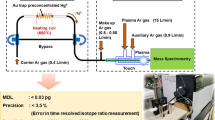Abstract
The analytical performance of an axial inductively-coupled-plasma time-of-flight mass spectrometer (ICP–TOFMS) as a detector for fast transient chromatographic signals resulting from the coupling to capillary gas chromatography (CGC) was investigated. A cryotrapping GC–ICP–TOFMS method for the determination of volatile metal(loid) compounds (VOMs) in gases was used and the suitability of the TOF mass analyzer for multi-elemental speciation analysis and multi-isotope ratio determinations was studied in terms of accuracy and precision. Isotope ratios 118Sn/120Sn and 121Sb/123Sb have been determined in in-house gas standard atmospheres in Tedlar bags at two different levels (100 pg and 1 ng) for different elemental species (SnH4, MeSnH3, Me2SnH2, Me3SnH, BuSnH3, SbH3, and MeSbH2). A limitation arising from counting statistics in both detection modes could be shown. A solution containing rhodium (10 ng mL–1) and cadmium (40 ng mL–1) was introduced simultaneously to the GC outlet. Rhodium acts as a continuous internal standard and Cd is used for mass-bias correction (by measuring the 111Cd/113Cd ratio). The detection system in both pulse counting and analog mode was examined. The best attainable precision was established for Me2SnH2 (analog mode, 12 replicates, 1 ng, RSD 0.34%, accuracy 0.31%) whereas most other species ranged between 0.4 and 0.5% RSD if higher concentrations were used. The limitations of the pulse counting system are clearly seen, with peak heights of more than 2000 counts reaching saturation (for an integration time of 100 ms), which reduces the accuracy of isotope ratio determinations. A dozen VOM could be detected in an aged landfill gas sample; several unidentified Sn compounds were present. Although their isotope ratios are within the confidence value of the standards, it is not yet clear if the acquired precision is good enough to identify isotopic fractionation of metal(loid)s through biovolatilization processes. With the precision achieved, the combination of cryotrapping GC and ICP–TOFMS is a powerful tool for monitoring volatile multi-element species in multi-tracer experiments and isotope dilution methodology.
Similar content being viewed by others
Author information
Authors and Affiliations
Additional information
Received: 23 November 2000 / Revised: 19 February 2001 / Accepted: 24 February 2001
Rights and permissions
About this article
Cite this article
Haas, K., Feldmann, J., Wennrich, R. et al. Species-specific isotope-ratio measurements of volatile tin and antimony compounds using capillary GC–ICP–time-of-flight MS. Fresenius J Anal Chem 370, 587–596 (2001). https://doi.org/10.1007/s002160100797
Published:
Issue Date:
DOI: https://doi.org/10.1007/s002160100797




